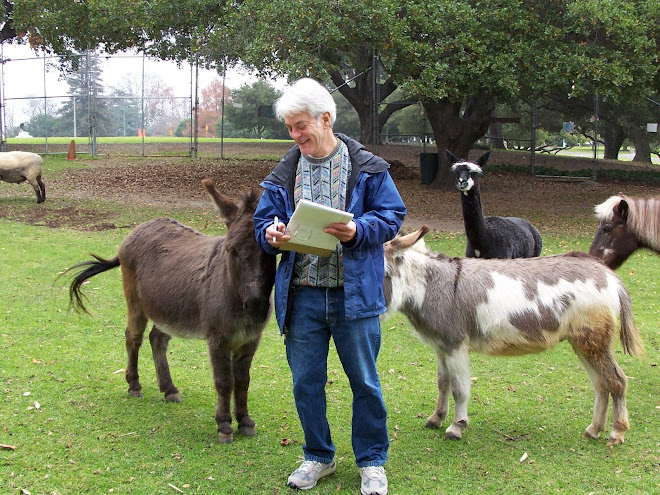
Zoey Stoll and Micah McKechnie have never met each other, but they have a lot in common.
Both are scary smart, both hail from Oakland (Zoey is a junior at Oakland Tech; Micah is a junior at UC Santa Barbara) and both have a neurologically-based condition called synesthesia.
I know that sounds like a horrible disease, but it's actually something wonderful.
Synesthesia is a term scientists use to describe what happens when stimulating one sense causes an involuntary response in another sense.
In Zoey's case, it's her visual sense. When she reads, each letter and number has a specific color, gender and personality.
"It can be a real advantage," she says. "If I see a math problem, I see it in a range of colors, which is pretty cool. And it's hard for me to misspell a word because if I do, the colors don't line up right."
She feels sorry for the rest of us, who read only in black and white.
"I'm really glad I have synesthesia. Reading would be so boring without it."
Often, the letters in each word will take their cue from the first letter. If the first letter is feminine, the other letters in the word probably will be, too.
"For instance, 'M' and 'S' are feminine letters," she said. "'So I hate to tell you, but 'Martin Snapp' is a very feminine name."
When she was a little girl, she used to write science fiction stories influenced by her synesthesia.
"One of my stories was about a green planet, and all the names of places on the planet were words that started with a green letter," she says.
Micah share's Zoey's sensitivity to letters and numbers, but she's even more sensitive to vibrations, especially sounds.
"It allows me to escape in my head," she says. "Whenever I'm on a long car ride or stuck in school doing absolutely nothing for lunch, I can just close my eyes and see amazing shapes and colors from every sound I hear. I wish I were more of an artist so I could draw them."
Needless to say, music is an utter joy for her. When she closes her eyes she sees light shows that are infinitely better than anything I used to see at the Avalon or the Fillmore back in the 196Os. And she doesn't need drugs to do it, either.
That's another thing she and Zoey have in common: They adamantly refuse to touch drugs or alcohol, and for a simple reason.
"I don't like anything that messes with my head," says Micah. "I'm already there. I don't need that."
And there's one more advantage. Micah has loved horses since she was a little girl, and her riding instructors have always marveled at her perfect riding form.
"If you flex a muscle, that's just another type of vibration," she explains. "So I can see all my muscles when I'm riding. If my form is off even a little bit, I can see that in my mind."
Not much is known about this syndrome, although it seems to affect a lot of creative people.
Famous synesthetes include composers Duke Ellington, Franz Liszt and Nikolai Rimsky-Korsakov, painters David Hockney and Wassily Kandinsky, novelist Vladimir Nabokov and physicist Richard Feynman.
I'm curious: Just how widespread is this syndrome? If you have synesthesia, too, please write me and describe your experiences. I'm absolutely fascinated - and, frankly, a little jealous.














3 comments:
You asked to hear from readers with synesthesia. For most of my life I could "see" sudden noises, especially if my eyes were closed. Like lightning bolts, they would shoot (in color or in white) across my visual field. Imagine the colors when the dentist was drilling! As a young adult, I was surprised to learn (when it occurred to me to inquire) that this happened to no one else I knew As an adult, I researched this phenomenon, and read that it was part of the limbic (primitive) brain, which I found particularly fascinating. I realized about fifteen years ago (I am now in my mid-sixties) that this was fading away. I wonder if this is true for other synesthesiasts -- if their synesthesia diminishes in post-middle-age. Richelle Jacobs, Oakland, CA
I too had synesthesia when I was growing up. Each number had a color as did each letter. I never talked about it and never heard of anyone else having it. Then I read a newspaper article about it and saw that sometimes it is hereditary. I asked my grown sons (twins) and they both have it! They see numbers and letters in color but not they same colors as I do.
I have spatial synesthesia. Months of the year and days of the week form in these specific "places". The months of the year are much like a block-print C, with January being at the bottom opening and then the rest of the months next to it, moving upward. The last four months are at the top section of the C. After December 31 there is this black space signifying the end of the year. The next day, the C starts over at January 1. Weeks move in the opposite direction, and it's more like a chain link. Monday is at the top, and then the rest of the weeks move left, or counter-clockwise. Saturday is before the break in the chain. Sunday is after.
Post a Comment